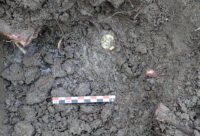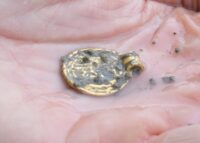 A small hoard of Migration Period gold bracteates has been unearthed in Råde, southeastern Norway’s. The first four were discovered in 2019 by archaeologists and a metal detectorist. Last fall, a more in depth archaeological investigation of the find site revealed three more bracteates near a rock at the edge of the field. The seven were originally a single votive deposit that was scattered centuries later by agricultural work. This is the first bracteate find of more than one individual found in Norway in 70 years. Only 90 bracteate deposition groups like this one have been found in all of Scandinavia.
A small hoard of Migration Period gold bracteates has been unearthed in Råde, southeastern Norway’s. The first four were discovered in 2019 by archaeologists and a metal detectorist. Last fall, a more in depth archaeological investigation of the find site revealed three more bracteates near a rock at the edge of the field. The seven were originally a single votive deposit that was scattered centuries later by agricultural work. This is the first bracteate find of more than one individual found in Norway in 70 years. Only 90 bracteate deposition groups like this one have been found in all of Scandinavia.
Inspired by the imperial Roman coinage that was melted down to produce them, bracteates were thin gold discs with gold beading around the rim and a loop fixed to the top. They were stamped on one side with diademed rulers, animals or figures from Norse mythology. They were produced between the 5th and 6th centuries, not as currency but as jewelry and status symbols. About 900 bracteates have been found in Sweden, Denmark, Norway, Germany, England. Only 160 of them were discovered in Norway.
Bracteates come in distinct types which have been classified as A, B, C and D based on their decorative motifs. A-types feature a diademed profile with runic characters around the border. B-types feature one to three human figures. C-bracteates feature a large head with hair over a horse, sometimes in combination with other animals and symbols. Ds feature stylized zoomorphic figures that can be hard to identify.
 The seven discovered in Råde are C and D types, four of the former and three of the latter. As Ds are estimated to be the youngest variant, dating to the 6th century, which means the deposit could not have been made before 500 A.D. So expensive and rare a votive offering may have been spurred by calamity, and a series of volcanic eruptions in 536-540 generated such thick ash clouds that they obscured the sun for a year and caused widespread crop failure and starvation.
The seven discovered in Råde are C and D types, four of the former and three of the latter. As Ds are estimated to be the youngest variant, dating to the 6th century, which means the deposit could not have been made before 500 A.D. So expensive and rare a votive offering may have been spurred by calamity, and a series of volcanic eruptions in 536-540 generated such thick ash clouds that they obscured the sun for a year and caused widespread crop failure and starvation.
The seven gold bracteates will now be studied in detail at the UiO Museum of Cultural History in Oslo. Some of them are a bit bent and the motifs are partly hidden. Using advanced technology, the archaeologists hope to be able to say something about how the pendants were made, and perhaps even by whom and where.
They will also compare the newly found bracteates to old findings. This might tell us something about connections between the elites in Scandinavia or Northern Europe.
“Laying down seven gold bracteates must have been a considerable ritual act, reserved for only the most privileged in society”, the archaeologists write. “Thus, they are also bearers of stories from the time before they were given as offerings”.